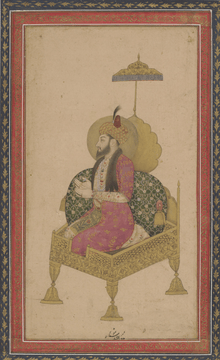Miran Shah
| Jalal-ud-din Miran Shah جلال الدین میران شاہ | |||||
|---|---|---|---|---|---|
|
Timurid Prince Miran Shah | |||||
 Mughal illumination of Miran Shah | |||||
| Born | 1366 | ||||
| Died |
1408 (aged 41–42) Sardrud, Timurid Empire (present-day Iran) | ||||
| Burial | Gur-e-Amir, Samarkand (present-day Uzbekistan) | ||||
| Spouse |
Daulatgaldi Agha Sevin Beg (Khanzada) Urun Sultan Khanum Murad Agha Ruhparwar Agha Nigar Agha Fakhira Agha Bakht Sultan Agha Dawlat Bakht Agha Mihr Nush Agha | ||||
| Issue |
Sayyidi Ahmad Mirza Khalil Sultan Mirza Muhammad Qasim Mirza Abu Bakr Mirza Umar Mirza Muhammad Timur Mirza Sultan Muhammad Mirza Ijil Mirza Suyurghatmish Mirza Biki Sultan Begum Qutlugh Sultan Begum Sa'adat Sultan Begum Rajab Sultan Begum Rabia Sultan Begum | ||||
| |||||
| House | House of Timur | ||||
| Father | Timur | ||||
| Mother | Mengli Khatun Jauni Qurban | ||||
| Religion | Islam | ||||
Mirza Jalal-ud-din[1] Miran Shah Beg (1366 – 16? April 1408) (Persian: میران شاہ) was a son of Timur, and a Timurid governor during his father's lifetime.
Governorship

Miran Shah's first charge was a vast region centered on Qandahar, which he was granted in 1383. That same year, he destroyed a rebellion against Timurid authority by the Kartids, then vassals of Timur in Khurasan under their leader Ghyas al-Din. To solidify control over the area, in 1396 he invited the remaining Kartid princes to a banquet and slew them.
In 1396 Miran Shah was given control of Azerbaijan, principally the cities of Soltaniyeh, the former capital of the Ilkhans, and Tabriz. In the summer of 1398 he marched from Tabriz with the goal of subduing the Jalayirids of Baghdad, but was forced to call off the expedition. Meanwhile, rumors had come to Timur that his son was planning to betray him. The conqueror was also angry over Miran Shah's refusal to solve the problems of tax dodgers within his area, and over his son's inability to keep the important fortress of Alinjaq out of the hands of the Jalayirids. In 1399 Timur sent a force under his nephew Sulaiman Shah to summon Miran Shah. The latter came with Sulaiman Shah willingly back to his father, where he was deposed of his governorship and assigned to his father's company for four years. His friends and advisors were executed.
Wars
In the winter of 1386 Miran Shah defeated an invading force of the Golden Horde that was on its way to Persia. He captured several prisoners, but these were released under light conditions when handed over to Timur.
Succession
Because of mental difficulties caused by an accident, Miran Shah was not a candidate for succeeding Timur. In the struggle that followed Timur's death in 1405, his son Aba Bakr managed to oust Jalayirid forces from Tabriz and Miran Shah reestablished himself in Azerbaijan. At the same time, Miran Shah supported another son, Khalil Sultan, in his claims to the throne. He marched with Aba Bakr in an attempt to reinforce Khalil, but eventually turned back. Meanwhile, he had to deal with the growing threat of the Black Sheep Turkmen, under Qara Yusuf. The latter defeated Aba Bakr at Nakhichevan in 1406 and again at Sardrud in 1408. In the last battle, Miran Shah was killed.
The line of Miran Shah continued to play a prominent role in the remnants of the Timurid Empire, when Abu Sa'id came to power in Transoxiana. He is also the ancestor of Babur, the founder of the Mughal Empire.[2]
Wives of Miran Shah
Miran Shah married three times:
- Daulatgaldi Agha, daughter of Payanda Sultan bin Jahangir Barlas;
- Sevin Beg Agha known as Khanzada, widow of Jahangir Mirza, daughter of Aq Sufi Husayn Qunqirat and Shukur Beg Agha (daughter of Jani Beg);
- Urun Sultan Khanika, daughter of Suyurghatgmish Khan Ogeday;
His concubines were:
- Murad Agha;
- Ruhparwar Agha;
- Nigar Agha;
- Fakhira Agha;
- Bakht Sultan Agha;
- Dawlat Bakht Agha, a Fuladbuqakhani lady;
- Mihr Nush Agha, another Fuladbuqakhani lady;
Sons of Miran Shah
- Khalil Sultan ibn Miran Shah
- Abu Bakr ibn Miran Shah
- Alankar Mirza,
- Uthmān Calbī Mirza
- Ījil Mirza
- Siyūrghtamish Mirza
- Muhammad Mirza
- Abu Sa'id Mirza
- Sultan Ahmed Mirza
- Sultan Mahmud Mirza
- Mirza Ulugh Beg II
- Umar Shaikh Mirza II
- Zahir-ud-din Muhammad Babur
- the Mughals
- Jahangir Mirza II
- Nasir Mirza
- Zahir-ud-din Muhammad Babur
- Abu Sa'id Mirza
References
- ↑ Humaira Faiz Dasti, Multan, a province of the Mughal Empire, 1525-1751 (1998), p. 48
- ↑ Bonnie C. Wade (20 July 1998). Imaging Sound: An Ethnomusicological Study of Music, Art, and Culture in Mughal India. University of Chicago Press. pp. 43–. ISBN 978-0-226-86840-0.
- Peter Jackson (1986). The Cambridge History of Iran, Volume Six: The Timurid and Safavid Periods. ISBN 0-521-20094-6